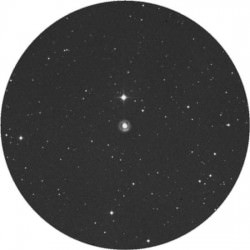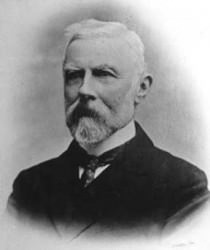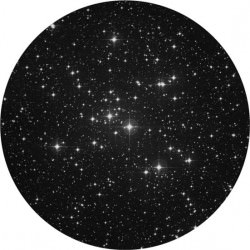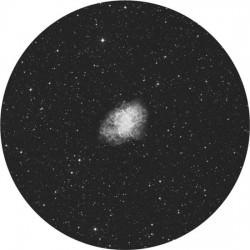Greetings, fellow SkyWatchers! What better way to celebrate a snow-bound weekend than by having a look at the “Eskimo”! While we’re at it, we’ll take a look at an awesome open cluster suitable for all optics and take an adventure towards one of the best supernovae remnants in the night sky. Along the way, we’ll explore some of the history and mystery behind these objects, so dust off your optics and I’ll see you in the backyard….
 Friday, February 12, 2010 – Today is unofficially Physicist’s Day! We’ll begin by celebrating three notable births on this date, starting in 1893 with Marcel Minnaert, solar physicist. Minnaert’s innovative techniques in solar spectrophotometry aided the discovery of structure in the Sun’s outer layers. Next is 1918 and Julian Schwinger, a physicist big on electromagnetic field theory, who shared the Nobel Prize for work in quantum electrodynamics. Last is the 1936 birth of Fang Lizhi, who published his work on the Big Bang theory in 1972. Even in exile from Communist China, he continues to express his belief in freedom of intellectual expression and continues his work in theoretical cosmology.
Friday, February 12, 2010 – Today is unofficially Physicist’s Day! We’ll begin by celebrating three notable births on this date, starting in 1893 with Marcel Minnaert, solar physicist. Minnaert’s innovative techniques in solar spectrophotometry aided the discovery of structure in the Sun’s outer layers. Next is 1918 and Julian Schwinger, a physicist big on electromagnetic field theory, who shared the Nobel Prize for work in quantum electrodynamics. Last is the 1936 birth of Fang Lizhi, who published his work on the Big Bang theory in 1972. Even in exile from Communist China, he continues to express his belief in freedom of intellectual expression and continues his work in theoretical cosmology.
 Tonight we’ll time-travel back 5,000 years as we head for NGC 2392. Located about two fingerwidths southeast of Delta Geminorum (RA 07 29 10 Dec +20 54 42), this beauty is a planetary nebula commonly known as the ‘‘Eskimo.’’ Discovered in 1787 by Sir William Herschel, a small telescope will see it as a fuzzy green star, while aperture will reveal definite annulus around its central stellar point. A steady night helps to reveal details, and a nebula filter lights it up! NGC 2392 is so complex that it is not yet fully understood. As with Minnaert’s solar work, we know the glowing gases are the outer layers of its central star, shed 10,000 years ago, while the inner ribbons of light (called filaments) are areas where particles are being pushed away by the strong stellar wind. Even now, we still can’t quite explain the unusual outer filaments! It won’t look like a Hubble image in your telescope, but you can still marvel at a unique mystery—seeing its light as it was when ‘‘physicists’’ began using the first ‘‘computer’’—the newly invented abacus!
Tonight we’ll time-travel back 5,000 years as we head for NGC 2392. Located about two fingerwidths southeast of Delta Geminorum (RA 07 29 10 Dec +20 54 42), this beauty is a planetary nebula commonly known as the ‘‘Eskimo.’’ Discovered in 1787 by Sir William Herschel, a small telescope will see it as a fuzzy green star, while aperture will reveal definite annulus around its central stellar point. A steady night helps to reveal details, and a nebula filter lights it up! NGC 2392 is so complex that it is not yet fully understood. As with Minnaert’s solar work, we know the glowing gases are the outer layers of its central star, shed 10,000 years ago, while the inner ribbons of light (called filaments) are areas where particles are being pushed away by the strong stellar wind. Even now, we still can’t quite explain the unusual outer filaments! It won’t look like a Hubble image in your telescope, but you can still marvel at a unique mystery—seeing its light as it was when ‘‘physicists’’ began using the first ‘‘computer’’—the newly invented abacus!
 February 13, 2010 – We salute Johan Ludvig Emil Dreyer, who was born on this date in 1852. At age 30, Danish astronomer Dreyer became director of the Armagh Observatory—not a grand honor, considering the observatory was so broke it couldn’t afford to replace its equipment. Like all good directors, Dreyer somehow managed to get a new 1000 refractor but no funds for an assistant to practice traditional astronomy. However, J.L.E. was dedicated and within 6 years had compiled all observations known to him into one unified work called the New General Catalogue of Nebulae and Clusters of Stars (NGC). Originally containing 7,840 objects, and supplemented in 1895 and 1908 with another 5,386 designations, the NGC remains the standard reference catalog. Although Dreyer’s personal observations included such nebulous descriptions as ‘‘a vault of stars,’’ modern astronomers continue to use his abbreviations as a kind of shorthand.
February 13, 2010 – We salute Johan Ludvig Emil Dreyer, who was born on this date in 1852. At age 30, Danish astronomer Dreyer became director of the Armagh Observatory—not a grand honor, considering the observatory was so broke it couldn’t afford to replace its equipment. Like all good directors, Dreyer somehow managed to get a new 1000 refractor but no funds for an assistant to practice traditional astronomy. However, J.L.E. was dedicated and within 6 years had compiled all observations known to him into one unified work called the New General Catalogue of Nebulae and Clusters of Stars (NGC). Originally containing 7,840 objects, and supplemented in 1895 and 1908 with another 5,386 designations, the NGC remains the standard reference catalog. Although Dreyer’s personal observations included such nebulous descriptions as ‘‘a vault of stars,’’ modern astronomers continue to use his abbreviations as a kind of shorthand.
 Honor Dreyer tonight by discovering one of his catalog objects suited for all optics—NGC2287. Located about two finger-widths south of Alpha Canis Majoris (RA 06 46 00 Dec +20 46 00), only an open cluster this bright could stand up against brilliant Sirius. From a dark-sky location, your unaided eye can even spot this magnitude 4.5 star vault as a hazy patch. Aristotle saw it as early as 325 BC! Officially discovered by Hodierna, we know it best by the designation Messier Object 41. Even from 2,300 light-years away, the cluster’s brightest star, an orange giant, stands out clearly from the stellar nest. With large aperture, you’ll notice other K-type stars, all very similar to Sol. Although small scopes and binoculars won’t reveal too much color, you might pick up on the blue signature of young, hot stars. NGC 2287 could be anywhere from 190 to 240 million years old, but its stars shine as brightly now as they did in Aristotle’s day. . .and Dreyer’s!
Honor Dreyer tonight by discovering one of his catalog objects suited for all optics—NGC2287. Located about two finger-widths south of Alpha Canis Majoris (RA 06 46 00 Dec +20 46 00), only an open cluster this bright could stand up against brilliant Sirius. From a dark-sky location, your unaided eye can even spot this magnitude 4.5 star vault as a hazy patch. Aristotle saw it as early as 325 BC! Officially discovered by Hodierna, we know it best by the designation Messier Object 41. Even from 2,300 light-years away, the cluster’s brightest star, an orange giant, stands out clearly from the stellar nest. With large aperture, you’ll notice other K-type stars, all very similar to Sol. Although small scopes and binoculars won’t reveal too much color, you might pick up on the blue signature of young, hot stars. NGC 2287 could be anywhere from 190 to 240 million years old, but its stars shine as brightly now as they did in Aristotle’s day. . .and Dreyer’s!
 February 14, 2010 – On this date in 1747, astronomer James Bradley presented his evidence of Earth’s wobble, called nutation. The study took 19 years, but won Bradley the Copley Medal! In 1827, George Clark was born. The name might not ring a bell, but it was indeed a bell—melted down—that he used to create his first brass telescope. George’s family went on to produce the finest—and largest—telescopes of their time. In 1898 one of my personal heroes, Fritz Zwicky came along, his name synonymous with the theory of supernovae. The Swiss-born Caltech professor was also a salty character, often intimidating his colleague Walter Baade and referring to others as ‘‘spherical bastards.’’ Although Zwicky was reportedly difficult to work with (geez… wonder why?), he was also brilliant—predicting the phenomenon of gravitational lensing. An unsung genius!
February 14, 2010 – On this date in 1747, astronomer James Bradley presented his evidence of Earth’s wobble, called nutation. The study took 19 years, but won Bradley the Copley Medal! In 1827, George Clark was born. The name might not ring a bell, but it was indeed a bell—melted down—that he used to create his first brass telescope. George’s family went on to produce the finest—and largest—telescopes of their time. In 1898 one of my personal heroes, Fritz Zwicky came along, his name synonymous with the theory of supernovae. The Swiss-born Caltech professor was also a salty character, often intimidating his colleague Walter Baade and referring to others as ‘‘spherical bastards.’’ Although Zwicky was reportedly difficult to work with (geez… wonder why?), he was also brilliant—predicting the phenomenon of gravitational lensing. An unsung genius!
 Tonight we’ll look at a supernova remnant as we venture to the Crab Nebula. Finding M1 is easy: it can be seen with as little as 7x magnification. Locate Zeta Tauri (about halfway between Orion’s ‘‘head’’ and the southernmost bright star in Auriga) and aim about 1 degree northwest (RA 05 34 31 Dec +22 00 52). Viewing M1 with small optics helps to understand why Charles Messier decided to compile his famous catalog. Unaware of its earlier discovery, Messier located a fuzzy object near the ecliptic and assumed it was the return of Halley’s Comet. Considering his primitive telescope, we can’t fault his observation. But Chuck was a good astronomer. When he realized the object wasn’t in motion, he began compiling a log of things not to be confused with comets—the famous Messier objects. Enjoy looking at this spectacular deep-sky jewel, and we’ll study it in depth another time. Of course, Zwicky may have cursed me for saying that observing without science is an ‘‘empty brain exercise and therefore a waste of time.’’ But on the date of his birth, I took his advice. . . ‘‘Give me a topic and I’ll give you an idea!’’
Tonight we’ll look at a supernova remnant as we venture to the Crab Nebula. Finding M1 is easy: it can be seen with as little as 7x magnification. Locate Zeta Tauri (about halfway between Orion’s ‘‘head’’ and the southernmost bright star in Auriga) and aim about 1 degree northwest (RA 05 34 31 Dec +22 00 52). Viewing M1 with small optics helps to understand why Charles Messier decided to compile his famous catalog. Unaware of its earlier discovery, Messier located a fuzzy object near the ecliptic and assumed it was the return of Halley’s Comet. Considering his primitive telescope, we can’t fault his observation. But Chuck was a good astronomer. When he realized the object wasn’t in motion, he began compiling a log of things not to be confused with comets—the famous Messier objects. Enjoy looking at this spectacular deep-sky jewel, and we’ll study it in depth another time. Of course, Zwicky may have cursed me for saying that observing without science is an ‘‘empty brain exercise and therefore a waste of time.’’ But on the date of his birth, I took his advice. . . ‘‘Give me a topic and I’ll give you an idea!’’
Until next week? Dreams really do come true when you keep on reaching for the stars!
This week’s awesome stellar images are from Palomar Observatory, courtesy of Caltech. We thank you so much!

